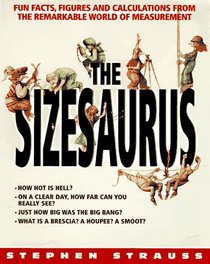Helpful Score: 1
The first half of the book is a collection of essays and the second starts with a list of definitions of weights and measures terms and continues with comparisons of various things to give a sense of the quantity being measured; for example, to talk about illumination, we are given for comparison an overcast sky, a candle flame, the sun, a lightning flash, among others; to talk about speed, we are given the growth rate of a child, speed a bacteria moves, the speed Heinz ketchup comes out of the bottle, speed of a cockroach, and the speed the astronauts traveled on the moon. As you can see, it is often silly, but I found it entertaining and thought-provoking. Some difficult concepts are made much easier to understand with the silliness.
One thing that this book stresses is that all systems of weights and measures are arbitrary. One of the essays talks about the history of measurement, the politics of measurement throughout history and what led up to the adoption of the metric system. Other essays include "How hot is Hell, anyway?," "Cold enough to freeze the misconceptions off a brass monkey," and "Big Mac measures the universe."
The biggest drawback for some Americans will be the fact that the book was written by a Canadian who is much more familiar with the metric system than with US customary units, but this edition is specifically edited for Americans, and does not assume a familiarity with the metric system.
There is also an abbreviated index of conversions. I would not necessarily recommend this book as a reference text; rather, it could be thought of as an entertaining way to explore the world of measurement.
For educational nonfiction, it's a wild ride.
One thing that this book stresses is that all systems of weights and measures are arbitrary. One of the essays talks about the history of measurement, the politics of measurement throughout history and what led up to the adoption of the metric system. Other essays include "How hot is Hell, anyway?," "Cold enough to freeze the misconceptions off a brass monkey," and "Big Mac measures the universe."
The biggest drawback for some Americans will be the fact that the book was written by a Canadian who is much more familiar with the metric system than with US customary units, but this edition is specifically edited for Americans, and does not assume a familiarity with the metric system.
There is also an abbreviated index of conversions. I would not necessarily recommend this book as a reference text; rather, it could be thought of as an entertaining way to explore the world of measurement.
For educational nonfiction, it's a wild ride.




